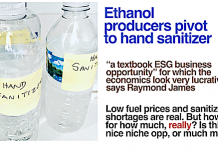Jim Lane 
Revenue and customer numbers are up at Solazyme (SZYM), 60% YOY growth from Q3 2013 to Q3 2014. But a slowdown in the rollout at Moema capacity leads to a spectacular 58% one-day drop in the stock price.
What happened?
Solazyme has been on a relatively steady downward trajectory for the past few quarters, dropping from the $11-$13 range and down into the $6-$8 range.
And then plunged a stunning 58 percent to $3.14 yesterday – amidst downgrades by Cowen & Company, Pacific Crest and Baird generally to Market Perform or Neutral, and remains at “Underweight” over at Piper Jaffray. Target stock prices have come way down.
All this carnage, we might add, even after a signature partnership with Versalis was announced to commercialize Encapso dilling oils. Versalis said that its initial emphasis for Encapso will be oil and gas fields operated by its parent company Eni, which represent a significant amount of the world’s petroleum drilling activity. Encapso will be featured as part of the company’s recently launched Specialty Oilfield Chemicals product portfolio.
What exactly gives for San Francisco’s [advanced bioeconomy] Giants?
Here’s the news
Total revenue for the third quarter of 2014 was $17.6 million compared with $10.6 million in the third quarter of 2013, an increase of 65%. Third quarter GAAP net loss was $39.7 million, which compares with net loss of $30.7 million in the prior year period. On a non-GAAP basis, the net loss was $35.3 million for the third quarter of 2014, compared with net loss of $22.3 million in the prior year quarter. A reconciliation of GAAP to non-GAAP results are included below.
“Our Clinton/Galva and Peoria facilities are performing well,” said CEO Jonathan Wolfson.”
Good news, so far. Then this:
“Progress at Moema is more mixed with the upstream process operating as expected, while the downstream process will require continued work to establish consistent, fully integrated operations.”
Analysts would, as we’ll see later in this report, used this new guidance from Brazilian operations as a catalyst to downshift the revenue growth rate to around 15% for 2015, targeting $70M instead of $350M.
Then this, on the company’s strategy.
“Commercially, we’re continuing to establish our Encapso and AlgaVia products in the marketplace while focusing additional attention on the development of higher value specialty products,” Wolfson said. “Strategically, we’re moving to intensify our focus on our high-value specialty portfolio, a move that will alter the near-term trajectory of our production ramp but which we believe will ultimately drive greater value for the Company.”
CFO Tyler Painter summarized:
“Our near term focus is on bringing Moema to fully integrated operations and focusing commercial activity around our high-value specialty products. As we execute on these goals, we are emphasizing prudent management of our capital, optimizing our product mix and positioning our manufacturing assets to maximize returns.”
Analysts would use this shift in strategy as further reason to downshift revenue growth, push out the “reaching break-even date” and raise the specter of a dilutive capital raise in 2015 to ensure liquidity for the company on its elongated timeline.
In plain-spoken words
Moema’s delayed, the big volumes are now in 2016 or 2017, so we’re shifting to higher margin, lower-volume markets.
What the analysts say
Pavel Molchanov at Raymond James expressed “frustration” with Moema delay, but said the “strategy makes sense” and saw value with the stock so far down. He wrote:
Downstream issues at Moema: frustrating, but ubiquitous in the space. Production challenges based on downstream processes at the Moema plant in Brazil are the main factors behind the slower-than-expected production scale-up and move down the manufacturing cost curve. Early costs at Moema were both higher, and lasted longer, than originally anticipated. Choppy power and steam operations – yes, something as prosaic as that – are among the specific culprits. None of this, to be sure, pertains to the core of Solazyme’s technology platform, but it’s frustrating nonetheless.
Slow ramp spurs retooling of production strategy. The operational shortfalls at Moema have led to a rethink of the strategy for production expansion. The new mantra – and E&P investors will be very familiar with this – is “value not volume”. Solazyme will further narrow the product range (and thus the scope of customers served), leading to lower sales volumes but higher pricing and blended margins…All in all, we think the strategy makes sense, even though the market clearly does not like the top-line pushout (shares are down 20% pre-market), and we continue to recommend buying the stock, particularly on weakness today.
Jeffrey Osborne at Cowen & Company was rethinking the models. He wrote:
Solazyme reported sub-par results for Q314. Management’s shift from high volume capacity to lower volume / high margin sales comes as a surprise, in the wake of low ASPs in its popular oils. Encapso and AlgaVia progress was stressed, and 2015 sales were guided well below consensus. With the loss of Moema as a catalyst, we are lowering our rating to Market Perform, and our price target to $7
Management’s overhaul in business strategy follows negative margins in typically lower margin product areas. As a result, the company has guided for only a 15% increase in 2015 revenue
The shifted focus to low-volume, high margin sales, in tandem with operational benchmarks falling short, is inhibiting the company from consolidating Moema’s operations in 2015 financials. This accounts for the ~$70 million in 2015 revenue guidance falling drastically short from our and consensus estimates (we were at $350 million previously for 2015).
Management has noted that despite delays, it expects to fully bring Moema onto its balance sheet in 2016, albeit not producing at the previously intended annual capacity of 100k MT/yr. We expect the Moema run rate to fall short of 20k MT/yr by 2016, given the change in strategy, as well as a pause in the completion of the Clinton facility ramp. This could prove ultra conservative; however, we would rather set the bar low.
Meanwhile, Mike Ritzenthaler of Piper Jaffray was trying out for Les Miserables. He wrote:
Start-up & reliability issues, the slower pace of market adoption, and lower than expected ASPs have substantially delayed execution timelines; management used the conference call to reset investor expectations much lower. Even with the technology working as expected, the timeline needed to ramp the facilities (including Moema which is currently experiencing operational issues) is well beyond previous expectations. The business model shift toward value products versus volumes is not surprising, but we continue to see material risk from niche market development and a sizeable capacity overhang (new partner Versalis is targeting ~3k MT of Encapso sales, or ~2.5% of capacity). Further, we see a capital infusion in 1H15 as likely and no longer believe that cash break-even in FY15 is reasonable. We have made healthy cuts to estimates, which result in a lower price target (to $2 from $4) and we maintain our Underweight rating.
The anatomy of the stock’s free-fall
You can see
it right here. The news came out last night, and there was a huge imbalance in the buy-sell. The stock was routed before trading started, opening at $3.85, and falling throughout the day to a intraday low of $2.98 before rebounding to $3.14 at the close.

We’ve seen it before. Pounding of earlier-stage stocks for any delays in the march to break-even. Doubtless we’ll see it again.
Those are timing issues for investors and legitimate for their purposes, of course. But let’s focus on the larger story here while significant ramp-up risk is out there for the long-term, investors have priced in almost zero revenue growth next year, at this stock price, if we take the Cowen & Company analysis which pegged a $4 target price to 15% growth.

Which makes this an opportunity for those who see in the Eni deal the means of revenue growth that investors have discounted for the near-term.
Jim Lane is editor and publisher of Biofuels Digest where this article was originally published. Biofuels Digest is the most widely read Biofuels daily read by 14,000+ organizations. Subscribe here.








